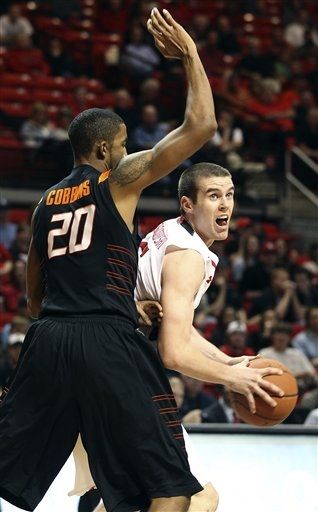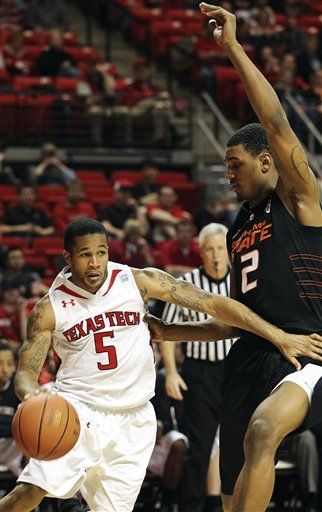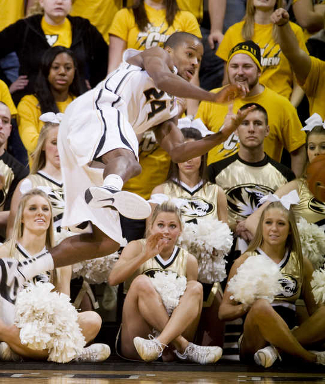| #4/4 Missouri Tigers 67, Texas Longhorns 66
If the sport were horseshoes or hand grenades, these Texas Longhorns would be All-Stars. Instead, Texas fans were treated to another verse of the same old song, as their team made another furious late-game comeback, only to come up short in a 67-66 loss.
Down 10 with just less than four minutes left, the Longhorns quickly erased the deficit, taking the lead on a leaner by J’Covan Brown with 56 seconds to go. Missouri’s Michael Dixon responded on the other end, tossing in a layup with 31 seconds left to put the Tigers back on top.
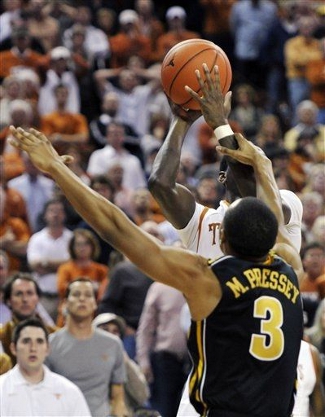
Myck Kabongo’s final shot couldn’t find the mark
(Photo credit: Michael Thomas/Associated Press)
On the final possession, Texas spread the floor against a surprise zone defense, with the ball coming to Brown with just over 12 seconds left on the clock. The Tigers pushed out in a two-man trap, and Brown whipped a cross-court pass to Myck Kabongo, who had to leap to keep the ball in play. His baseline drive and jumper fell short, and Texas dropped to 0-7 in games decided by six points or less.
What looked good
The Texas defense in the first half was stifling. After being torched early in the teams’ first meeting in Columbia, the Longhorns were prepared to shut down the nation’s second-best offense. Texas defenders stayed in the shirts of the Missouri shooters on the perimeter, forcing them to pass it around.
Although there were a few possessions in which a Tiger slashed to the rack unchallenged, it was a vast improvement over the first meeting between the two teams. In fact, the Tigers were held to just 0.834 points per possession in the first half, well off their season average of 1.22.
The Longhorns capitalized on that tough defense by closing out possessions with rebounds. They dominated the glass on both ends of the floor, limiting Missouri to an offensive rebounding percentage of just 21.4%, while reclaiming 44.4% of their own misses. That workmanlike effort on the boards equated to a sizeable 22-6 advantage for Texas in second chance points.
Freshman Jonathan Holmes was the team leader in boards, snagging nine on the night. His effort on the glass led to easy putback points, and he was able to log seven points for the game. Unfortunately, he also led the team in turnovers with five, which was absolutely crippling in a game decided by one point.
Fellow freshman Jaylen Bond was also tenacious inside. He ripped down seven rebounds in just 14 minutes on the court and came up with two clutch buckets following offensive rebounds. Tempo-free stats underscore just how important Bond was during his short time on the court, as his personal offensive rebounding percentage was an incredible 23.8%, while his defensive was 40.8%.
The Longhorns also benefitted from aggressive play by Julien Lewis, who repeatedly attacked with drives from the corner. He started coming on strong in the second half of the Baylor game, and that confidence seemed to carry over into this one. Lewis led the way early for the Horns, seeming to be the only consistent scorer in a first half where the team had troubling putting the ball in the hoop. In the end, the freshman finished with 12 points on 44% shooting, a much more efficient contribution than his early performances in Big 12 play.
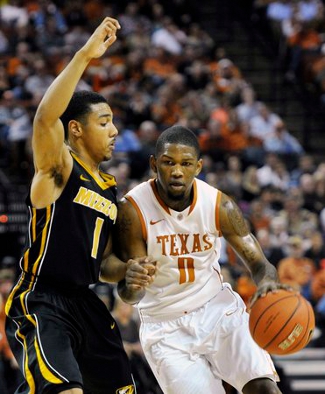
Julien Lewis attacked the rim for Texas
(Photo credit: Michael Thomas/Associated Press)
Big men Clint Chapman and Alexis Wangmene were a big part of Lewis’ success in this one, providing solid seals on the help defense when he drove to the rim. Chapman also showed off some agility with a few nice post moves, scoring six points in just 23 minutes on the court.
What needed work
Unfortunately, the fifth-year senior also had some tough moments on defense. In the first half, he let Ricardo Ratliffe establish very deep post position on a lob entry that had Coach Rick Barnes absolutely livid. He called an immediate timeout and angrily motioned Chapman to the bench with a jerk of the thumb. In the second half, Chapman was so intent on not letting Ratliffe get another easy bucket that he actually backed off a driving Tiger guard to prevent the dumpoff pass, instead giving up an uncontested layup.
Brown also played matador defense, although his struggles were much more consistent than Chapman’s. In the second half, he allowed Dixon to score in bunches. In the post-game press conference, Brown told the media, “I basically gave up half his points.” He couldn’t stay in front of Missouri’s speedy sixth man, letting Dixon spark a second-half scoring explosion for the Tigers.
Texas also did itself no favors with another rash of turnovers. In the first half, the Longhorns managed just 22 points, due in large part to a turnover rate close to 25%. For the game, Texas was able to push that mark down to just 19.9%, but those 13 miscues turned into 14 Tiger points. Perhaps the most frustrating was a second-half turnover by Myck Kabongo, who compounded his error by intentionally fouling Phil Pressey to give the Tigers two shots and the ball.
The Texas offense didn’t just bog down solely due to turnovers. The Longhorns often tried to establish Chapman or Wangmene in the post, but entry passes from the wing were simply not available. Typically, the big would then move out to the perimeter to set a ball screen, but the driving lanes were usually cut off by Missouri defenders.
Instead of reacting to the Tiger defense with quick ball movement, the Longhorns spread out the floor and played isolation basketball. With the team’s only buckets coming from one-on-one drives and offensive putbacks, Texas actually headed to the locker room without a single assist. They didn’t do much better in the second half, adding just five assists, one of them coming on a three-man fast-break.
For the third consecutive game, free throws were an albatross for the Longhorns. The team shot just 66.7% from the line, leaving eight freebies on the table. Texas did a great job of attacking and earning trips to the line, but did not take advantage of their edge in free throw attempts. You could even say the Longhorns left a ninth point at the line, as one of those misses came when Wangmene couldn’t hit the front end of a one-and-one.
In the last three games, the Longhorns have made just 63.2% of their free throws, a sharp decline from the season average of 73.2% that they carried into the first of those three games. For much of the season, the one thing that the Texas offense could count on was an ability to manufacture points at the line. Instead, trips to the charity stripe have become a scary proposition during the most important part of the season.
Finally, it must be noted that once again the Longhorns looked completely lost on the final possession of a close game. It’s one thing to lose a lot of close ones when the breaks just don’t go your way, but Texas has repeatedly failed to get good looks late in the game. The final possession against Kansas State resulted in a turnover and fast-break bucket, while Brown felt that his last-second three against Baylor wasn’t a bad look, despite Coach Barnes telling him the exact opposite.
Against the Tigers, the Longhorns had a play drawn up for both man and zone defenses. The Tigers came out in a zone look, and Texas spread the floor. Coach Barnes told the media that players weren’t making their cuts, which led to the breakdown. What he didn’t explain to reporters was why he didn’t use the team’s final timeout to regroup once he saw the players failing to make hard cuts. The Longhorns had more than 20 seconds left on the clock at the start of that final possession, but wasted thirteen of them before Brown’s risky cross-court pass set up Kabongo for his missed final shot.
The big picture

Clint Chapman and the Horns need a quick turnaround
(Photo credit: Michael Thomas/Associated Press)
Texas is rapidly running out of opportunities to log a signature win, with just two games against Top 5 opponents left on the docket. During the final two weeks of the season, the Longhorns host Baylor and travel to Phog Allen Fieldhouse. Kansas State also travels to the Erwin Center on February 11th, but their recent slide has nearly sent them out of the RPI Top 50.
Texas has almost no margin for error at this point, essentially needing to win every game outside of the Baylor and Kansas match-ups. The odds aren’t in their favor, as the Longhorns still have road trips left to A&M, Oklahoma, and Oklahoma State. Despite all three programs having down years, those teams still defend their home court well, and a Texas road win is far from a guarantee.
If the Longhorns pulled off the improbable run and beat everyone left on the schedule not named Kansas or Baylor, it would put them at 20-9 overall. Even though losses to the Jayhawks and Bears would give them a respectable 20-11 record in this hypothetical, the Longhorns would still be left with just two or three wins against the RPI Top 50, with Temple being the team’s best win on the year.
The odds are long for Texas at this point, but with nine games left on the season, you can’t write Texas off just yet. If they can learn from all of these close losses and regroup in time to attack the favorable back half of their league slate, perhaps the Longhorns can finally put together a run.
Up next: vs. Texas Tech (7-13 overall, 0-8 Big 12); Saturday, 6 P.M. CT
| 







